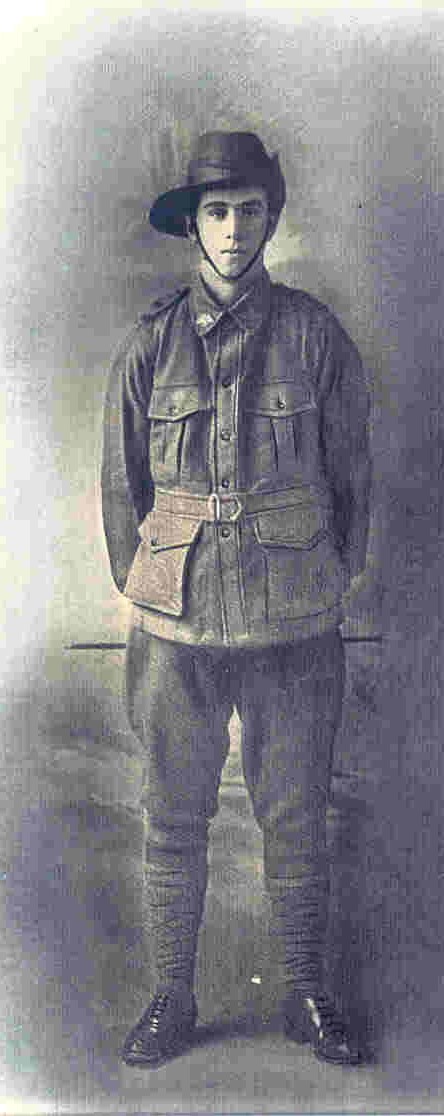Pte
Mervyn Gladstone Harris
Informatie over geboorte
|
Geboortedatum: 28/10/1897 |
|
Geboorteplaats: Argalong, New South Wales, Australië |
Algemene Informatie
|
Beroep: Arbeider |
Informatie legerdienst
|
Land: Australië |
|
Strijdmacht: Australian Imperial Force |
|
Rang: Private |
|
Service nummer: 6268 |
|
Dienstneming datum: 10/05/1916 |
|
Dienstneming plaats: Cootamundra, New South Wales, Australië |
|
Eenheden: — Australian Infantry, 2nd Bn. (Laatst gekende eenheid) |
Informatie over overlijden
|
Datum van overlijden: 18/09/1917 |
|
Plaats van overlijden: Clapham Junction, Zonnebeke, België |
|
Doodsoorzaak: Killed in action (K.I.A.) |
|
Leeftijd: 19 |
Gedenkplaats
|
Ypres (Menin Gate) Memorial Paneel: 32 |
Onderscheidingen en medailles 2
|
British War Medal Medaille |
|
Victory Medal Medaille |
Points of interest 3
| #1 | Geboorteplaats | ||
| #2 | Dienstneming plaats | ||
| #3 | Plaats van overlijden (bij benadering) |
Mijn verhaal
Mervyn Gladstone Harris was born on October 28th 1897 in Argalong, New South Wales. He was one of eleven children. Before he enlisted in the army he worked as a labourer. When he enlisted, he joined the 2nd Battalion of the Australian Infantry, part of the 1st Australian Brigade of the 1st Australian Division. His date of death is mentioned incorrectly on the Commonwealth War Grave Commission, for he died on 18th September 1917 and not the 11th September as the CWGC mentions.
On September 16th his battalion moved from Mic Mac Camp to the Hooge area where they relieved the 15th Battalion of the London Regiment in support. The battalion was distributed as follows: “A” and “B” Companies and a platoon of “C” Company were in Ignorance Trench, south of Château Wood, the other three platoons of “C” Company were in the Menin Road Tunnel. “D” Company was positioned in the Zouave Trench. Battalion Headquarters were in Château Wood.
Relief, however, was carried out during daylight and was observed by the Germans. The tracks the battalion used were frequently shelled. From September 16th until September 19th was spent in improving the very poor accommodations and carrying forward ammunition from the Divisional Dump at Hooge Crater to the forward brigade dumps at Clapham Junction. For these duties up to 300 men were continuously employed. The carrying parties were in constant danger, as they used tracks, which were under German observation.
One of the casualties during this period was 19-year-old Mervyn Gladstone Harris. He was killed in action on the 18th of September 1917. He has no known grave and is remembered on the Menin Gate, Panel 32.
On September 16th his battalion moved from Mic Mac Camp to the Hooge area where they relieved the 15th Battalion of the London Regiment in support. The battalion was distributed as follows: “A” and “B” Companies and a platoon of “C” Company were in Ignorance Trench, south of Château Wood, the other three platoons of “C” Company were in the Menin Road Tunnel. “D” Company was positioned in the Zouave Trench. Battalion Headquarters were in Château Wood.
Relief, however, was carried out during daylight and was observed by the Germans. The tracks the battalion used were frequently shelled. From September 16th until September 19th was spent in improving the very poor accommodations and carrying forward ammunition from the Divisional Dump at Hooge Crater to the forward brigade dumps at Clapham Junction. For these duties up to 300 men were continuously employed. The carrying parties were in constant danger, as they used tracks, which were under German observation.
One of the casualties during this period was 19-year-old Mervyn Gladstone Harris. He was killed in action on the 18th of September 1917. He has no known grave and is remembered on the Menin Gate, Panel 32.
Bronnen 6
|
AIF Project https://www.aif.adfa.edu.au/showPerson?pid=128455&printFormat=print Gebruikte bronnen |
|
Australian War Memorial https://www.awm.gov.au/advanced-search/people?people_preferred_name=harris&people_service_number=6268&people_unit= Gebruikte bronnen |
|
CWGC https://www.cwgc.org/find-war-dead/casualty/924039/harris,-mervyn-gladstone/ Gebruikte bronnen |
|
Service File https://recordsearch.naa.gov.au/SearchNRetrieve/Interface/DetailsReports/ItemDetail.aspx?Barcode=4764978&isAv=N Gebruikte bronnen |
|
Trench Maps https://maps.nls.uk/geo/find/#zoom=12.51333333333333&lat=50.92658&lon=2.96648&layers=60&b=1&z=1&point=0,0 Gebruikte bronnen |
|
War Diary https://www.awm.gov.au/collection/C1347981 Gebruikte bronnen |
